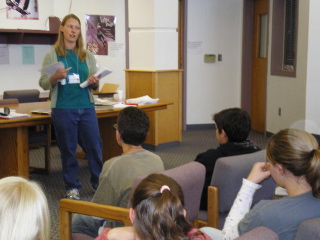Some young people struggle to connect to history. If you
have young athletes, try looking at sports from other times and in other
cultures. Finding the similarities can be a way to get kids interested in
history.
For example, the Maya had games and toys that may still seem
familiar. Here’s a description from Life
among the Maya:
Even with all their duties, Maya children found some time to
play. They probably had dolls and toy animals, and they used a marked board and
beans to play a game something like checkers. They likely played ball games
using rubber balls. In a few western Mexico villages today, the Maya play a ball
game probably descended from the ancient version.
Editor Colleen P. Popson studied the game for Archaeology magazine and described the
scoring system. “A team wins points when the opposing team makes an error, like
missing the ball, hitting out of turn, extending over the center line when
returning a serve, knocking the ball out of bounds, failing to announce the
score after winning a point, touching the ball with the hands, or, curiously,
accidentally touching a teammate. If a ball stops moving before it reaches the
center line, it is a … dead ball, and a point for the other team. The team to
score eight points first wins.”
 |
| Projects can connect historical fiction, history, the arts and more |
Learning through
Playing
Board games were also popular: In The Mystery of the Ancient Maya, Meyer and Gallenkamp say, “Markets
were, as well, meeting places where people gathered and exchanged ideas with
visitors from other areas. There may have been games of chance when people got
together to trade and talk. One popular marketplace game was played by throwing
'dice' – kernels of dried corn painted with black marks – and betting on how
they would fall.”
On her now-defunct website, Nancy McNelly described the Maya
game Bul.
“‘Game boards’ have been found scratched into the stone of
building floors and the bases of stelae….
“In Bul, a ‘board’ was made by placing 15 grains of corn in
a row, the 14 spaces between grains being used for play. Four flat grains of
corn with a black mark burned into one side served as dice. When the grains
were tossed the count was based on the number that fell with the burned side up
(1 burned side and 3 unburned = 1, etc.). But if all the kernels came up blank,
the count was 5.
“Bul can be played with any even number of participants. The
example used here is the simplest arrangement, with only 2 players. Each player
has 5 game pieces; these could be any readily available item: seeds, sticks,
bits of cloth, etc. …
“Opposing players each start with a single game piece at
opposite ends of the board; each gets two throws of the corn in a row,
advancing his marker the number of spaces indicated after each throw. When a
game piece reaches the opposite end of the board, it is re-entered at the end
where it started, as if the board were circular.
“The real point was to land on a space already occupied by
your opponent. You would then take the other game piece ‘captive’ and change
direction to drag it back to your ‘home’ end of the board. Once this was done,
you could re-enter your piece into play, while the captive marker was ‘dead’.
Play continued in this way until all of one side’s pieces were dead.
“With two players, as soon as one captured the other’s
marker, there was no way to prevent it from being carried off the board. With
multiple players divided into two teams, the situation was different. [Partners
could rescue each other by] dragging both the captured piece and the opponent’s
marker towards the other end of the board, where the partner’s marker was freed
to be put back into play, while the opponent’s piece was dead. If enough people
were involved in the game, it could take up to three hours for all of one
side’s pieces to be killed.”
If you are studying the Maya, how about trying one of these
games?
Adding Historical
Fiction
You can round out the lesson by reading historical fiction
that includes sports and games. In The
Well of Sacrifice, Eveningstar Macaw watches an exciting ball game:
Our team started with the ball, which was as big as my head
and made of hard, solid rubber. The leader tossed the ball up and then bounced
it off the thick protective pad he wore around his hips. The ball hit the
sloped stone wall on the side of the court and spun back. Another player dove
and managed to deflect the ball off his arm pad….
The novel also includes a Mayan legend about how the Hero
Twins bested the Lords of Death in several challenges, including a ballgame. Read
that legend online at Teaching the Myths.
Learning history through games and sports can work in the
classroom or with homeschooling. But you don't have to be a teacher – anyone
can have fun learning history while playing games!
Get lesson plans to use with The Well of Sacrifice, The Eyes of Pharaoh, and The Genies Gift at the "For Teachers" tab on my website.
Chris
Eboch’s novels for ages nine and up include The
Eyes of Pharaoh, a mystery in ancient Egypt; The Well of Sacrifice, a Mayan adventure; The Genie’s Gift, a middle eastern fantasy; and the Haunted series,
about kids who travel with a ghost hunter TV show, which starts with The Ghost on the Stairs. Her writing craft
books include You Can Write for Children:
How to Write Great Stories, Articles, and Books for Kids and Teenagers, and
Advanced Plotting. Learn more at www.chriseboch.com or her Amazon page.




















